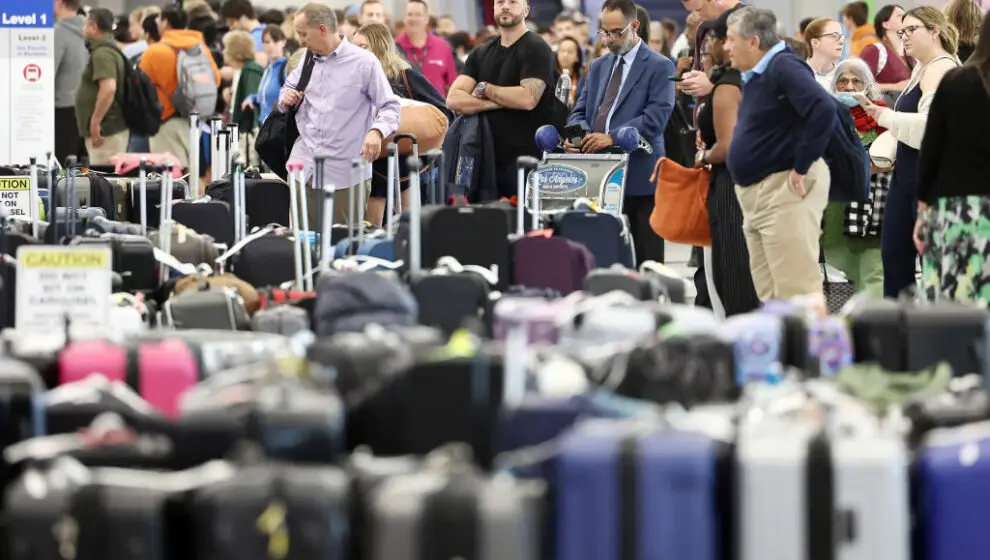Ahead of the July 4 weekend, travelers can expect to experience delays and cancellations, similar to the holiday-travel debacles from last year.
Key Details
- Airlines experienced their first major travel disruption of the summer this week as several summer storms hit the East Coast, resulting in thousands of cancellations and delays.
- Last year, travelers experienced frequent cancellations and delays related to weather and labor shortages. Until this week, air travel this year had been noticeably more reliable.
- Companies had better prepared themselves for the summer travel season by hiring additional staff and working alongside regulators. The first holiday of the summer, Memorial Day, went smoothly.
- Though poor weather conditions are outside airlines’ control, the spate of cancellations renews a lack of confidence from customers.
Why it’s news
Major airlines, including United Airlines, Delta Air Lines, and JetBlue Airways, announced over 7,500 canceled flights.
Most storms passed and allowed airlines to return to normal by Thursday, but United continued to experience disruptions. The mass cancellations required the carrier to overhaul its previously set schedule, and the company needed time to reassign crews and plot flight paths. United says that cancellations should taper off.
However, this weekend may be one of the busiest days for airlines since the COVID pandemic. Over the next week, the Transportation Security Administration (TSA) anticipates screening 17.7 million people. Around 2.82 million of those passengers are expected on Friday alone, The Wall Street Journal reports.
But the storms of earlier this week may not be the end of carriers’ woes. Smoke from the Canadian wildfires continues to spread across the East Coast and Midwest. Meanwhile, more storms are expected in both regions of the country. How much these conditions may affect travel is still unknown.
Backing up a bit
Last year, mass airline cancellations left passengers stranded in airport terminals and severely affected public trust in the method of transportation. Even before COVID, airlines noticed a problem with employee retention and recruitment. COVID worsened the issue, and flights were left without crews.
As if flight crew troubles were not enough, a failure of the Notice To Air Missions (NOTAM) system in January resulted in all flights being grounded for the first time since 9/11. This came just after mass Southwest Airlines cancellations that cost the company an estimated $100 million.
Some weather-related cancellations or delays are an expected part of air travel, but the mass cancellations eroded customer confidence. Regulators from the Federal Aviation Administration (FAA) stepped in to prevent further disruptions this year. This year had been smooth sailing until this week.
Breaking down what happened
New York was an expected trouble spot this summer. New York airports only have about 54% of the trained air-traffic controllers that the FAA suggests, The Wall Street Journal reports. While these controllers can handle flight traffic in good weather, the FAA worried that if bad weather came up, the available staff would be unable to handle the workload. In response, major airlines reduced flights to New York and worked with agency officials to better prepare for inclement weather.
Last Saturday, New York was hit with summer storms. Conditions worsened over the weekend, and several storms affected major traffic hubs like Boston, Atlanta, and Chicago. At the same time, air-traffic controllers in a Washington, D.C., facility experienced communications problems. On that Sunday alone, American Airlines diverted 70 flights.
The FAA jumped in early to help overwhelmed New York controllers. While additional support from the FAA hotline assisted understaffed airlines, the FAA was struggling with its own labor shortage on Sunday, The Wall Street Journal reports.
Troubles continued throughout the week as storms continued to hammer the East Coast. Except for Sunday, the FAA says that staffing was not an issue. While that may have been true this week, staffing is a long-term issue at the FAA. Training and retaining air-traffic controllers has been difficult, according to a Transportation Department inspector general report.
The number of fully-trained controllers has declined 10% over the last decade.
